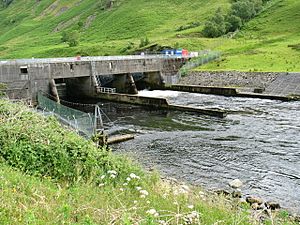River Awe facts for kids
The River Awe (which is Uisge Abha in Gaelic) is a short but important river in the beautiful Highlands of Scotland. It acts like a natural drain for the large freshwater Loch Awe, letting its water flow into Loch Etive. Loch Etive is a special type of loch called a sea loch, meaning it's connected to the ocean.
Exploring the River Awe
The River Awe might be short, but it plays a big role in the local area. It connects two important lochs and has been used by people for travel and power for a long time.
Where Does the River Awe Flow?
The journey of the River Awe begins at a special structure called a barrage. This barrage stretches across one end of Loch Awe. This part of the loch reaches out through a narrow valley known as the Pass of Brander. The river then flows from this point, heading towards the sea.
As the river makes its way, it's joined by some important travel routes. Both the railway line that goes from Glasgow to Oban and the A85 road follow the river for much of its path. These routes even cross over the River Awe about halfway along its length. You can also find a smaller road bridge and a footbridge crossing the river, making it easy for people to get around.
The River's Journey to the Sea
The River Awe eventually reaches its end at Loch Etive. It flows into this sea loch close to a small village called Taynuilt. Right next to where the river meets the loch, there's a jetty. This jetty was once a busy place where ferries would carry people and vehicles across the narrowest part of Loch Etive, using the B845 road.


